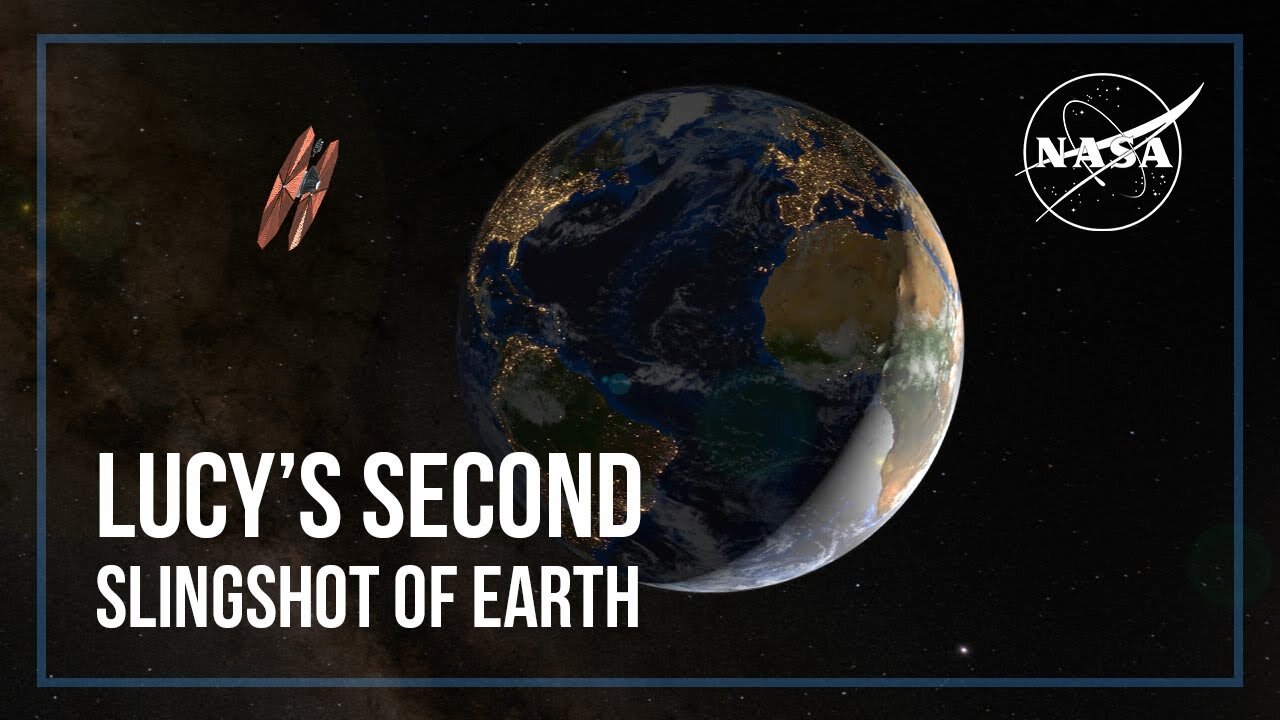Premium Only Content

Lucy Spacecraft’s Second Slingshot of Earth
NASA’s Lucy mission is heading to the Jupiter Trojans, two swarms of asteroids trapped in Jupiter’s orbit…but to get there, Lucy needs a little help from Earth. On December 12, 2024, the spacecraft will make its second close flyby of Earth (following an earlier gravity assist in October 2022). As night falls on Hawaii, Lucy will streak over the darkened Pacific Ocean, coming to within about 220 miles of the planet at 11:15 pm ET. The encounter will boost Lucy’s velocity by four-and-a-half miles per second relative to the Sun, putting it on course for the L4 Trojans that travel ahead of Jupiter.
Read more on the Lucy blog: https://blogs.nasa.gov/lucy/2024/12/1...
Credit: NASA’s Goddard Space Flight Center
Dan Gallagher: Producer/Narrator
Kel Elkins: Data Visualizer
Walt Feimer: Animator
Adriana Manrique Gutierrez: Animator
Jonathan North: Animator
Dan Gallagher: Animator
Katherine Kretke: Public Affairs
Nancy Jones: Public Affairs
Kathryn Mersmann: Support
Aaron E. Lepsch: Technical Support
Universal Production Music: “Determined Arrival 4-5” by Joel Goodman [ASCAP]; “Floating” by Nicholas Smith [PRS]; “Subtle Confidence 3” by Joel Goodman [ASCAP]
This video can be freely shared and downloaded at https://svs.gsfc.nasa.gov/14734. While the video in its entirety can be shared without permission, the music and some individual imagery may have been obtained through permission and may not be excised or remixed in other products. Specific details on such imagery may be found here: https://svs.gsfc.nasa.gov/14734. For more information on NASA’s media guidelines, visit https://nasa.gov/multimedia/guidelines.
Transcript:
0:00
[Music]
0:01
NASA's Lucy mission is heading to the Jupiter Trojans,
0:04
two swarms of asteroids trapped in Jupiter's orbit.
0:08
When it arrives,
0:09
it will provide the first close-up look at these primitive objects,
0:12
thought to be fossils from the dawn of the solar system.
0:15
But to get there, Lucy needs a little help from the Earth.
0:19
[Music]
0:24
After launching on October 16th, 2021,
0:27
Lucy returned home exactly one year later for the first of three
0:31
Earth gravity assists, stealing an undetectably small amount of Earth's
0:35
orbital energy to boost the spacecraft.
0:39
This allowed Lucy to skim the inner edge of the main asteroid
0:42
belt between Mars and Jupiter. On November 1st, 2023,
0:47
it flew by asteroid Dinkinesh
0:49
and discovered a small moon, which the mission named Selam.
0:53
Now, Lucy is returning home once again for another gravitational tug.
0:58
On December 12th, at 1:20 p.m.
1:01
Eastern Time, it will cross the Moon's orbit from the direction of the Sun,
1:05
greeted by a brilliant view of Australia and the Pacific Ocean.
1:09
In the hour before closest approach, Lucy will begin to rotate, or slew,
1:14
keeping the spacecraft stable as it skims through Earth's upper atmosphere.
1:18
Lucy will pick up speed is it approaches the evening terminator,
1:22
or boundary between day and night, crossing into Earth's shadow.
1:26
At 11:15 p.m., it will make its closest approach to the planet,
1:30
skimming about 220 miles above the ocean west of California.
1:35
Lucy will be traveling over nine miles per second,
1:38
allowing it to streak over North America in only seven minutes.
1:43
Just before midnight on the East Coast, Lucy will slew back toward the Sun,
1:47
catching a glimpse of sunrise over central Africa.
1:51
It will cross the Moon's orbit about half a day later, bidding
1:54
farewell to home until its third and final gravity assist in December 2030.
1:59
[Music]
2:02
The 2024 encounter will boost
2:03
Lucy's velocity by four-and-a-half miles per second relative to the Sun,
2:08
putting it on course for the L4 Trojans that travel ahead of Jupiter.
2:13
But first, Lucy will traverse the main asteroid belt,
2:16
making a flyby of asteroid Donaldjohanson on April 20th, 2025.
2:21
[Music]
-
 18:52
18:52
Producer Michael
16 hours agoI GOT PULLED OVER BY THE POLICE IN MIAMI!
8.67K2 -
 1:21:53
1:21:53
MTNTOUGH Fitness Lab
21 hours agoThe Fight That Almost Destroyed Jim Miller (& How He Overcame It) to Break UFC Records
33.4K3 -
 24:46
24:46
Cooking with Gruel
1 day agoFeeding Hope - LA Wildfire Relief from the People
26.8K7 -
 14:34
14:34
MichaelBisping
13 hours agoSean Strickland CONFRONTS Bisping! 'Pereira in Corner, Dricus and Khamzat!' (EXCLUSIVE INTERVIEW)
11.1K3 -
 59:54
59:54
Trumpet Daily
20 hours ago $3.34 earnedThe Trade War Ends - Trumpet Daily | Feb. 4, 2025
11.5K22 -
 5:44
5:44
DropItLikeItsScott
13 hours ago $0.11 earnedA Must Have Shotgun - GARAYSAR Fear 116
7.44K2 -
 56:14
56:14
PMG
19 hours ago $0.06 earnedHannah Faulkner and John Strand | BLANKET PARDON FOR ALL J6er's
38.3K3 -
 48:51
48:51
State of the Second Podcast
15 hours agoWhy Does Palmetto State Armory Keep Winning?
19K4 -
 32:01
32:01
SB Mowing
25 days agoHer Tears Said It All: “My Prayers Have Been Answered”
36.3K37 -
 3:28:55
3:28:55
Price of Reason
15 hours agoTrump Means Business! Disney's F4 Hail Mary Pass! Assassin's Creed Shadows Art Book SUCKS?
73.9K14